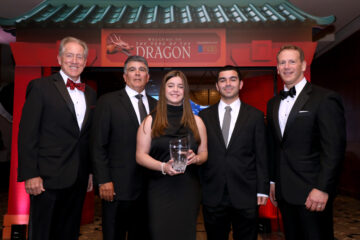
Photos/Susan Allen
ATLANTIC CITY – On their way to the beach in front of Stockton University, waves from a 9-foot southeast swell rolled over a series of scientific instruments installed by Stockton’s Coastal Research Center.
These were the waves that Alex Ferencz, a student in the Master’s in Environmental Science program, had been waiting for.
Ferencz, who is also a geospatial analyst and GIS program director at the CRC, has tracked coastal storms for years in pursuit of the perfect waves to ride on a surfboard. But this spring, he needed a storm that would give him data for his master’s thesis.
The instruments collected wave height, frequency and direction from 1,500 feet offshore all the way up to the dunes, and Ferencz is translating the numbers into a narrative that will tell how a storm can reshape a beach. His project will illustrate how the current moves sand on the seafloor and where exactly that sand ends up after the storm passes.
Wind-driven energy travels through the ocean as waves that eventually break when they reach shallow water, sending surges of seawater dune-ward. The shoreline is an ever-changing landscape.
Ferencz is analyzing data that will describe exactly how an extreme event from the southeast will impact the Atlantic City beach in front of Stockton’s campus, from the dunes out into the nearshore waters.

Kimberly McKenna, principal investigator and director of sponsored programs at the CRC, and Alex Ferencz, a PSM student who is also a geospatial analyst and GIS program director at the CRC, unpack the current meter. Before collecting his own data for his thesis, Ferencz worked with offshore current data from NOAA to compare how northern and southern New Jersey beaches react to storms.
Kimberly McKenna, principal investigator and director of sponsored programs at the CRC, secured funding from the New Jersey Sea Grant Consortium, an extension of a federal funding program, to make the project possible. This project marks the CRC’s first Sea Grant-funded initiative.
“We want students to look out the windows in Atlantic City and see the opportunity to do research on the beach,” McKenna said.
Eddie Waltz, a sophomore taking an independent study in coastal research; Matthew Deibert, an environmental science graduate and a geospatial analyst at the CRC; and Anna Pfeiffer-Herbert, assistant professor of Marine Science, also helped to prepare and deploy the instruments.
A concurrent experiment was conducted by the University of Delaware on a Delaware beach that has coarser sand grains and no sandbar. The results of that experiment combined with the Atlantic City findings will show how beaches with varying characteristics responded to the same storm.


